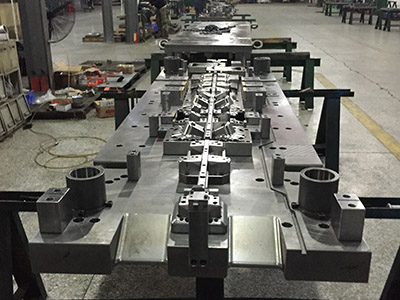4Industry information

Automobile mold, in a narrow sense, is the general term for stamping all stamping parts of the automobile body. That is, "car body stamping die". For example, the top cover flanging die, beam strengthening plate pressing die, etc.
Automobile mold
1. Injection mold
Injection moulds are also called injection moulds. The molding process of the mold is characterized by putting plastic raw materials into the heating cylinder of the injection molding machine. The plastic is heated and melted, pushed by the screw or plunger of the injection molding machine, and enters the mold cavity through the nozzle and pouring system of the mold. After heat preservation, pressure preservation and cooling, the plastic solidifies and forms in the mold cavity. Because the heating and pressurization device can play a role in stages, injection molding can not only form plastic parts with complex shapes, but also have high production efficiency and good quality. Therefore, injection molding occupies a large proportion in the molding of plastic parts, and injection molds account for more than half of plastic molding molds. Injection molding machine is mainly used for thermoplastic molding, and in recent years, it is also gradually used for thermosetting plastic molding.
2. Compression mold
The die is also called the die or the glue die. The molding process of the mold is characterized by adding the plastic raw material directly into the open mold cavity, and then closing the mold. After the plastic melts under the action of heat and pressure, the mold cavity is filled with a certain pressure. At this time, the molecular structure of the plastic produces a chemical cross-linking reaction and gradually hardens. The compression mold is mostly used for thermosetting plastics, and the molded plastic parts are mostly used for the shell of electrical switches and daily necessities.
3. Transfer mold
Transfer die is also called injection mold or extrusion die. The molding process of the mold is characterized by adding plastic raw materials to a preheated feed chamber, and then applying pressure to the plastic raw materials in the feed chamber through a pressure column. The plastic melts at high temperature and pressure, enters the mold cavity through the pouring system of the mold, and then undergoes a chemical cross-linking reaction to gradually cure and form. The transfer process is mainly used for thermosetting plastics and can be used to form plastic parts with complex shapes.
4. Extrusion die
Extrusion die head is also called extrusion head. This mold can continuously produce plastics with the same cross-section shape, such as plastic tubes, rods, sheets, etc. The heating and pressurizing device of the extruder is the same as that of the injection molding machine. After the molten plastic passes through the die head, continuous plastic parts are formed, and the production efficiency is particularly high.
In addition to the several plastic molds listed above, there are vacuum forming molds, compressed air molds, blow molds, low foaming plastic molds and so on.
The stamping parts of the car body are roughly divided into covering parts, beam frame parts and general stamping parts. The stamping parts that can clearly show the image characteristics of the car are the car covering parts. Therefore, the more specific automobile mold can be said to be "automobile covering stamping mold". Stamping die for automobile covering parts. For example, the front door plate cutting die, the front door inner plate punching die.
 JIANKE TOOL&DIE
JIANKE TOOL&DIE
